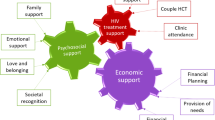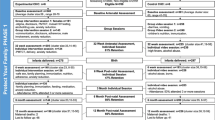Abstract
Male partner involvement is an important factor in prevention of mother-to-child transmission (PMTCT). Yet, poor conceptualization has hindered optimal assessment of male involvement. We created and evaluated a brief 10-item male partner involvement scale using principal components analysis and scree plots, Cronbach’s alpha, and linear regression with survey data from postpartum women with HIV (n = 200) in Kenya. The scale had a two-factor structure: male encouragement/reminders and active participation. The overall scale and the encouragement/reminders sub-scale displayed strong internal reliability. In the multivariable models, the scales were positively associated with constructive relationship dynamics, HIV status disclosure, and couple HIV testing and counseling, and negatively associated with internalized HIV stigma. The encouragements/reminders sub-scale was also negatively associated with a new HIV diagnosis during pregnancy. This work furthers the conceptualization of male partner involvement in PMTCT and provides a valid measure to assess male involvement as a pathway to better PMTCT outcomes.

Similar content being viewed by others
References
Hamilton E, Bossiky B, Ditekemena J, Esiru G, Fwamba F, Goga AE, et al. Using the PMTCT cascade to accelerate achievement of the global plan goals. J Acquir Immune Defic Syndr. 2017;75(Suppl 1):S27–35.
Wettstein C, Mugglin C, Egger M, Blaser N, Vizcaya LS, Estill J, et al. Missed opportunities to prevent mother-to-child-transmission: systematic review and meta-analysis. AIDS. 2012;26(18):2361–73.
Aluisio A, Bosire R, Bourke B, Gatuguta A, Kiarie JN, Nduati R, et al. Male partner participation in antenatal clinic services is associated with improved hiv-free survival among infants in Nairobi, Kenya: a prospective cohort study. J Acquir Immune Defic Syndr. 2016;73(2):169–76.
Baiden F, Remes P, Baiden R, Williams J, Hodgson A, Boelaert M, et al. Voluntary counseling and HIV testing for pregnant women in the Kassena-Nankana district of northern Ghana: is couple counseling the way forward? AIDS Care. 2005;17(5):648–57.
Chinkonde JR, Sundby J, Martinson F. The prevention of mother-to-child HIV transmission programme in Lilongwe, Malawi: why do so many women drop out. Reprod Health Matters. 2009;17(33):143–51.
Turan JM, Bukusi EA, Onono M, Holzemer WL, Miller S, Cohen CR. HIV/AIDS stigma and refusal of HIV testing among pregnant women in rural Kenya: results from the MAMAS study. AIDS Behav. 2011;15(6):1111–20.
Farquhar C, Kiarie JN, Richardson BA, Kabura MN, John FN, Nduati RW, et al. Antenatal couple counseling increases uptake of interventions to prevent HIV-1 transmission. J Acquir Immune Defic Syndr. 2004;37(5):1620–6.
Kiarie JN, Kreiss JK, Richardson BA, John-Stewart GC. Compliance with antiretroviral regimens to prevent perinatal HIV-1 transmission in Kenya. AIDS. 2003;17(1):65–71.
Turan JM, Hatcher AH, Medema-Wijnveen J, Onono M, Miller S, Bukusi EA, et al. The role of HIV-related stigma in utilization of skilled childbirth services in rural Kenya: a prospective mixed-methods study. PLoS Med. 2012;9(8):e1001295.
Jefferys LF, Nchimbi P, Mbezi P, Sewangi J, Theuring S. Official invitation letters to promote male partner attendance and couple voluntary HIV counselling and testing in antenatal care: an implementation study in Mbeya Region, Tanzania. Reprod Health. 2015;12:95.
Takah NF, Kennedy ITR, Johnman C. The impact of approaches in improving male partner involvement in the prevention of mother-to-child transmission of HIV on the uptake of maternal antiretroviral therapy among HIV-seropositive pregnant women in sub-Saharan Africa: a systematic review and meta-analysis. BMJ Open. 2017;7(11):e018207.
Nyondo-Mipando AL, Chimwaza AF, Muula AS. “He does not have to wait under a tree”: perceptions of men, women and health care workers on male partner involvement in prevention of mother to child transmission of human immunodeficiency virus services in Malawi. BMC Health Serv Res. 2018;18(1):187.
Kalembo FW, Zgambo M, Mulaga AN, Yukai D, Ahmed NI. Association between male partner involvement and the uptake of prevention of mother-to-child transmission of HIV (PMTCT) interventions in Mwanza district, Malawi: a retrospective cohort study. PLoS ONE. 2013;8(6):e66517.
Spangler SA, Onono M, Bukusi EA, Cohen CR, Turan JM. HIV-positive status disclosure and use of essential PMTCT and maternal health services in rural Kenya. J Acquir Immune Defic Syndr. 2014;67(Suppl 4):S235–42.
Mabachi NM, Brown M, Sandbulte M, Wexler C, Goggin K, Maloba M, et al. Using a social support framework to understand how HIV positive kenyan men engage in PMTCT/EID care: qualitative insights from male partners. AIDS Behav. 2019;1:1. https://doi.org/10.1007/s10461-019-02451-6.
WHO. Male involvement in the prevention of mother-to-child transmission of HIV. Geneva: World Health Organization; 2012.
Byamugisha R, Tumwine JK, Semiyaga N, Tylleskar T. Determinants of male involvement in the prevention of mother-to-child transmission of HIV programme in Eastern Uganda: a cross-sectional survey. Reprod Health. 2010;7:12.
Matseke MG, Ruiter RAC, Rodriguez VJ, Peltzer K, Setswe G, Sifunda S. Factors associated with male partner involvement in programs for the prevention of mother-to-child transmission of HIV in rural South Africa. Int J Environ Res Public Health. 2017;14(11):1333.
Peltzer K, Jones D, Weiss SM, Shikwane E. Promoting male involvement to improve PMTCT uptake and reduce antenatal HIV infection: a cluster randomized controlled trial protocol. BMC Public Health. 2011;11:778.
Tokhi M, Comrie-Thomson L, Davis J, Portela A, Chersich M, Luchters S. Involving men to improve maternal and newborn health: a systematic review of the effectiveness of interventions. PLoS ONE. 2018;13(1):e0191620.
NACC. Kenya HIV estimates: report 2018. National AIDS Control Council. Kenya Ministry of Health. 2018.
Odeny TA, Onono M, Owuor K, Helova A, Wanga I, Bukusi EA, et al. Maximizing adherence and retention for women living with HIV and their infants in Kenya (MOTIVATE! study): study protocol for a randomized controlled trial. Trials. 2018;19(1):77.
Creswell JW, Plano Clark VL. Designing and conducting mixed methods research. Thousand Oaks: SAGE; 2007. p. 275.
StataCorp. Stata Statistical Software: Release 14. College Station, TX: StataCorp LP. 2015.
Aluisio, A.R., Bosire, R., Betz, B., Gatuguta, A., Kiarie, J.N., Nduati, R., et al. Male partner participation in antenatal clinic services is associated with improved HIV-free survival among infants in Nairobi, Kenya: a prospective cohort study. J Acquir Immune Defic Syndr. 2016.
Sherr L, Croome N. Involving fathers in prevention of mother to child transmission initiatives–what the evidence suggests. J Int AIDS Soc. 2012;15(Suppl 2):17378.
Hampanda K. “It was from this encouragement I got used to taking the medication:”A Qualitative Study on Male Partner Support after Status Disclosure among Pregnant and Postpartum Women Living with HIV in Zambia. Alabama: Inter-CFAR Collaborative Symposium on HIV Research in Women; Birmingham; 2016.
Harris PA, Taylor R, Thielke R, Payne J, Gonzalez N, Conde JG. Research electronic data capture (REDCap)–a metadata-driven methodology and workflow process for providing translational research informatics support. J Biomed Inform. 2009;42(2):377–81.
Netemeyer RG, Bearden WO, Sharma S. Scaling procedures: issues and applications. Thousand Oaks: Sage; 2003. p. 203.
DeVellis RF. Scale development: theory and applications, 4th edn. Los Angeles: SAGE; 2017. p. 262.
Kaiser HF. An index of factor simplicity. Psychometrika. 1974;39:31–6.
Comrey AL, Lee HB. A first course in factor analysis. 2nd ed. Hillsdale: L. Erlbaum Associates; 1992. p. 430.
Orne-Gliemann J, Tchendjou PT, Miric M, Gadgil M, Butsashvili M, Eboko F, et al. Couple-oriented prenatal HIV counseling for HIV primary prevention: an acceptability study. BMC Public Health. 2010;10:197.
Betancourt TS, Abrams EJ, McBain R, Fawzi MC. Family-centred approaches to the prevention of mother to child transmission of HIV. J Int AIDS Soc. 2010;13(Suppl 2):S2.
Turan JM, Nalbant H, Bulut A, Sahip Y. Including expectant fathers in antenatal education programmes in Istanbul, Turkey. Reprod Health Matters. 2001;9(18):114–25.
Nyondo AL, Choko AT, Chimwaza AF, Muula AS. Invitation cards during pregnancy enhance male partner involvement in prevention of mother to child transmission (PMTCT) of human immunodeficiency virus (HIV) in Blantyre, Malawi: a randomized controlled open label trial. PLoS ONE. 2015;10(3):e0119273.
Katz DA, Kiarie JN, John-Stewart GC, Richardson BA, John FN, Farquhar C. Male perspectives on incorporating men into antenatal HIV counseling and testing. PLoS ONE. 2009;4(11):e7602.
World Health Organization. Progress Report 2016: Prevent HIV, Test and Treat All: WHO Support For Country Impact. Geneva: World Health Organization; 2016.
Rogers AJ, Achiro L, Bukusi EA, Hatcher AM, Kwena Z, Musoke PL, Turan JM, Weke E, Darbes LA. Couple interdependence impacts HIV-related health behaviours among pregnant couples in southwestern Kenya: a qualitative analysis. J Int AIDS Soc. 2016;19(1):21224.
Turan JM, Darbes LA, Musoke PL, Kwena Z, Rogers AJ, Hatcher AM, et al. Development and piloting of a home-based couples intervention during pregnancy and postpartum in Southwestern Kenya. AIDS Patient Care STDS. 2018;32(3):92–103.
Darbes LA, van Rooyen H, Hosegood V, Ngubane T, Johnson MO, Fritz K, et al. Uthando Lwethu (‘our love’): a protocol for a couples-based intervention to increase testing for HIV: a randomized controlled trial in rural KwaZulu-Natal, South Africa. Trials. 2014;15:64.
Hatcher AM, Stöckl H, Christofides N, Woollett N, Pallitto CC, Garcia-Moreno C, et al. Mechanisms linking intimate partner violence and prevention of mother-to-child transmission of HIV: a qualitative study in South Africa. Soc Sci Med. 2016;168:130–9.
Letta S, Demissie A, Oljira L, Dessie Y. Factors associated with adherence to Antiretroviral Therapy (ART) among adult people living with HIV and attending their clinical care, Eastern Ethiopia. BMC Int Health Hum Rights. 2015;15:33.
Mellins CA, Kang E, Leu CS, Havens JF, Chesney MA. Longitudinal study of mental health and psychosocial predictors of medical treatment adherence in mothers living with HIV disease. AIDS Patient Care STDS. 2003;17(8):407–16.
Hampanda KM, Turan JM, Helova A, Onono M, Odwar T, Hoople, K, Bukusi E, Abuogi LL. “When we come together, we leave with a common goal:” men’s perspectives on male partner involvement in the prevention of mother-to-child transmission. AIDS Impact 14th International Conference; 2019; London.
International Parenthood Federation (IPF), Global Network of People Living with HIV (GNP+), International Community of Women Living with HIV (ICW), UNAIDS. The People Living with HIV Stigma Index: an index to measure the stigma and discrimination experienced by people living with HIV London: International Parenthood Federation; 2008.
Kroenke K, Strine TW, Spitzer RL, Williams JB, Berry JT, Mokdad AH. The PHQ-8 as a measure of current depression in the general population. J Affect Disord. 2009;114(1–3):163–73.
Kroenke K, Spitzer RL, Williams JB, Lowe B. The patient health questionnaire somatic, anxiety, and depressive symptom scales: a systematic review. Gen Hosp Psychiatry. 2010;32(4):345–59.
Rusbult C, Martz J, Agnew C. The Investment Model Scale: measuring commitment level, satisfaction level, quality of alternatives, and investment size. Pers Relationsh. 1998;5(4):357–91.
Schuster TL, Kessler RC, Aseltine RH. Supportive interactions, negative interactions, and depressed mood. Am J Community Psychol. 1990;18(3):423–38.
Turner RJ, Frankel BG, Levin DM. Social support: conceptualization, measurement, and implications for mental health. Res Community Ment Health. 1983;3:67–111.
Funding
This work was supported by the National Institute of Mental Health under Grant K99MH116735; the National Institute of Child Health and Human Development under Grant R01HD080477; and the National Institute of Allergy and Infectious Disease-funded Colorado HIV Research Training Program under Grant 4T32AI007447. The content is solely the responsibility of the authors and does not necessarily represent the official views of the National Institutes of Health. The funders had no role in study design, data collection and analysis, decision to publish, or preparation of the manuscript.
Author information
Authors and Affiliations
Corresponding author
Ethics declarations
Conflict of interest
The authors declare that they have no conflict of interest.
Ethical Approval
All procedures performed involving human participants were in accordance with the ethical standards of the institutional and/or national research committees and with the 1964 Helsinki declaration and its later amendments or comparable ethical standards. Relevant institutional review boards at the University of Colorado Denver, University of Alabama Birmingham, and Kenya Medical Research Institute (KEMRI) provided ethical approval for the study. Individual consent was obtained by trained Kenyan research assistants who conducted an informed consent process, including a signed consent (or thumbprint) form and an information sheet read aloud in the participant’s preferred language.
Additional information
Publisher's Note
Springer Nature remains neutral with regard to jurisdictional claims in published maps and institutional affiliations.
Rights and permissions
About this article
Cite this article
Hampanda, K., Abuogi, L., Musoke, P. et al. Development of a Novel Scale to Measure Male Partner Involvement in the Prevention of Mother-to-Child Transmission of HIV in Kenya. AIDS Behav 24, 291–303 (2020). https://doi.org/10.1007/s10461-019-02546-0
Published:
Issue Date:
DOI: https://doi.org/10.1007/s10461-019-02546-0




